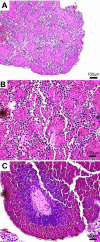Tumorigenesis and anti-tumor immune responses in Xenopus
- PMID: 19273061
- PMCID: PMC2749489
- DOI: 10.2741/3238
Tumorigenesis and anti-tumor immune responses in Xenopus
Abstract
Despite intense study, the role of the immune system in detecting (immunosurveillance), controlling and remodeling (immunoediting) neoplasia remains elusive. We present here a comparative view of the complex interactions between neoplasia and the host immune system. We provide evidence, in the amphibian Xenopus laevis, consistent with an evolutionarily conserved and crucial role of the immune system in controlling neoplasia, which involves a striking variety of anti-tumoral immune effectors including conventional CTLs, classical MHC class Ia unrestricted CTLs (CCU-CTLs) that interact with nonclassical MHC class Ib molecules, CD8 NKT-like cells and NK cells. We also review the tumors found in X. laevis with an emphasis on thymic lymphoid tumors and a rare ovarian dysgerminoma. Finally, we consider the use of X. laevis for in vivo study of tumorigenesis. Given our current knowledge, the experimental systems already established in X. laevis, and the rapid accumulation of genetic resources for the sister species Silurana (Xenopus) tropicalis, it is our conviction that these species provide an ideal alternative to the murine system for studying tumorigenesis and tumor immunity.
Figures


References
-
- Peters EC, Halas JC, McCarty HB. Calicoblastic neoplasms in Acropora palmata, with a review of reports on anomalies of growth and form in corals. J Natl Cancer Inst. 1986;76:895–912. - PubMed
-
- Berry LW, Westlund B, Schedl T. Germ-line tumor formation caused by activation of glp-1, a Caenorhabditis elegans member of the Notch family of receptors. Development. 1997;124:925–36. - PubMed
-
- Barker CM, Calvert RJ, Walker CW, Reinisch CL. Detection of mutant p53 in clam leukemia cells. Exp Cell Res. 1997;232(2):240–245. - PubMed
-
- Kelley ML, Winge P, Heaney JD, Stephens RE, Farell JH, Van Beneden RJ, Reinisch CL, Lesser MP, Walker CW. Expression of homologues for p53 and p73 in the softshell clam (Mya arenaria), a naturally-occurring model for human cancer. Oncogene. 2001;20(6):748–758. - PubMed
-
- Sparks AK. Observations on the history of non-insect invertebrate pathology from the perspective of a participant. J Invert Pathol. 2005;89(1):67–77. - PubMed
Publication types
MeSH terms
Grants and funding
LinkOut - more resources
Full Text Sources
Research Materials

